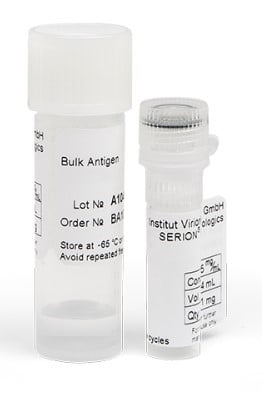| Weight | 1 lbs |
|---|---|
| Dimensions | 9 × 5 × 2 in |
| host | mouse |
| isotype | IgG1 |
| clonality | monoclonal |
| concentration | 1 mg/mL |
| applications | ICC/IF, WB |
| reactivity | Calnexin |
| available sizes | 100 µg |
mouse anti-Calnexin monoclonal antibody (C2A1) 9154
$520.00
Antibody summary
- Mouse monoclonal to Calnexin
- Suitable for: WB,IHC
- Isotype: IgG1
- 100 µg
mouse anti-Calnexin monoclonal antibody (C2A1) 9154
| antibody |
|---|
| Tested applications WB,IHC,IHC |
| Recommended dilutions Immunoblotting: use at 1-10ug/ml. Immunohistochemistry: use at 1-10ug/ml. These are recommended concentrations. End user should determine optimal concentrations for their applications. |
| Immunogen Dictyostelium discoideum AX2 recombinant fragment. Accession no. P27824. |
| Size and concentration 100µg and |
| Form lyophilized |
| Storage Instructions This product is stable for at least one (1) year at -20°C to -70°C. Reconstituted product should be stored in appropriate aliquots to avoid repeated freeze-thaw cycles. |
| Storage buffer Lyophilized, 0.1M Tris, 0.1M glycine, 2% sucrose |
| Purity protein affinity purification |
| Clonality monoclonal |
| Isotype IgG1 |
| Compatible secondaries goat anti-mouse IgG, H&L chain specific, peroxidase conjugated polyclonal antibody 5486 goat anti-mouse IgG, H&L chain specific, biotin conjugated, Conjugate polyclonal antibody 2685 goat anti-mouse IgG, H&L chain specific, FITC conjugated polyclonal antibody 7854 goat anti-mouse IgG, H&L chain specific, peroxidase conjugated polyclonal antibody, crossabsorbed 1706 goat anti-mouse IgG, H&L chain specific, biotin conjugated polyclonal antibody, crossabsorbed 1716 goat anti-mouse IgG, H&L chain specific, FITC conjugated polyclonal antibody, crossabsorbed 1721 |
| Isotype control Mouse monocolonal IgG1 - Isotype Control |
| target relevance |
|---|
| Protein names Calnexin (IP90) (Major histocompatibility complex class I antigen-binding protein p88) (p90) |
| Gene names CANX,CANX |
| Protein family Calreticulin family |
| Mass 67568Da |
| Function FUNCTION: Calcium-binding protein that interacts with newly synthesized monoglucosylated glycoproteins in the endoplasmic reticulum. It may act in assisting protein assembly and/or in the retention within the ER of unassembled protein subunits. It seems to play a major role in the quality control apparatus of the ER by the retention of incorrectly folded proteins. Associated with partial T-cell antigen receptor complexes that escape the ER of immature thymocytes, it may function as a signaling complex regulating thymocyte maturation. Additionally it may play a role in receptor-mediated endocytosis at the synapse. |
| Subellular location SUBCELLULAR LOCATION: Endoplasmic reticulum membrane {ECO:0000269|PubMed:22314232}; Single-pass type I membrane protein {ECO:0000255}. Mitochondrion membrane {ECO:0000250|UniProtKB:P24643}; Single-pass type I membrane protein {ECO:0000255}. Melanosome membrane {ECO:0000269|PubMed:12643545, ECO:0000269|PubMed:17081065}; Single-pass type I membrane protein {ECO:0000255}. Note=Identified by mass spectrometry in melanosome fractions from stage I to stage IV (PubMed:12643545, PubMed:17081065). The palmitoylated form preferentially localizes to the perinuclear rough ER (PubMed:22314232). Localizes to endoplasmic reticulum mitochondria-associated membrane (MAMs) that connect the endoplasmic reticulum and the mitochondria (By similarity). {ECO:0000250|UniProtKB:P24643, ECO:0000269|PubMed:12643545, ECO:0000269|PubMed:17081065, ECO:0000269|PubMed:22314232}. |
| Structure SUBUNIT: Interacts with MAPK3/ERK1 (By similarity). Interacts with KCNH2 (PubMed:16361248). Associates with ribosomes (By similarity). Interacts with SGIP1; involved in negative regulation of endocytosis (By similarity). The palmitoylated form interacts with the ribosome-translocon complex component SSR1, promoting efficient folding of glycoproteins (PubMed:22314232). Interacts with SERPINA2P/SERPINA2 and with the S and Z variants of SERPINA1 (PubMed:23826168). Interacts with PPIB (PubMed:20801878). Interacts with ZNRF4 (PubMed:21205830). Interacts with SMIM22 (PubMed:29765154). Interacts with TMX2 (PubMed:31735293). Interacts with TMEM35A/NACHO (By similarity). Interacts with CHRNA7 (PubMed:32783947). Interacts with reticulophagy regulators RETREG2 and RETREG3 (PubMed:34338405). Interacts with DNM1L; may form part of a larger protein complex at the ER-mitochondrial interface during mitochondrial fission (PubMed:24196833). Interacts with ADAM7 (By similarity). {ECO:0000250|UniProtKB:P35564, ECO:0000250|UniProtKB:P35565, ECO:0000269|PubMed:16361248, ECO:0000269|PubMed:20801878, ECO:0000269|PubMed:21205830, ECO:0000269|PubMed:22314232, ECO:0000269|PubMed:23826168, ECO:0000269|PubMed:29765154, ECO:0000269|PubMed:31735293, ECO:0000269|PubMed:32783947, ECO:0000269|PubMed:34338405}.; SUBUNIT: (Microbial infection) Interacts with HBV large envelope protein, isoform L. {ECO:0000269|PubMed:9188622}.; SUBUNIT: (Microbial infection) Interacts with HBV large envelope protein, isoform M; this association may be essential for isoform M proper secretion. {ECO:0000269|PubMed:9188622}. |
| Post-translational modification PTM: Phosphorylated at Ser-564 by MAPK3/ERK1. Phosphorylation by MAPK3/ERK1 increases its association with ribosomes (By similarity). {ECO:0000250}.; PTM: Palmitoylation by DHHC6 leads to the preferential localization to the perinuclear rough ER. It mediates the association of calnexin with the ribosome-translocon complex (RTC) which is required for efficient folding of glycosylated proteins. {ECO:0000269|PubMed:22314232}.; PTM: Ubiquitinated, leading to proteasomal degradation. Probably ubiquitinated by ZNRF4. {ECO:0000269|PubMed:21205830}. |
| Target Relevance information above includes information from UniProt accession: P27824 |
| The UniProt Consortium |
Data
| No results found |
Publications
| pmid | title | authors | citation |
|---|---|---|---|
| We haven't added any publications to our database yet. | |||
Protocols
| relevant to this product |
|---|
| Western blot IHC |
Documents
| # | SDS | Certificate | |
|---|---|---|---|
| Please enter your product and batch number here to retrieve product datasheet, SDS, and QC information. | |||
Only logged in customers who have purchased this product may leave a review.








Reviews
There are no reviews yet.